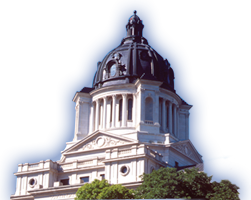South Dakota Democratic State Senate Delegation Slashed to 44-Year Low
Democratic delegation to State Senate cut by more than half on Tuesday

Not only did their brightest star, Blue Dog Democrat Stephanie Herseth Sandlin, narrowly lose her reelection bid for a fifth term against Republican Kristi Noem, but the Party’s already thin representation in the legislature was decimated. (Not to mention the fact Democrats failed to field a U.S. Senate candidate against John Thune for the first time in history).
The losses endured by the Democrats in the South Dakota House of Representatives were expected and not unusual.
Democratic membership of the 70-seat body dropped four seats from 24 to 20 – which has been the average number of seats won by the Party across the last seven election cycles in the House. (Smart Politics projected a loss of three seats).
Over the past 110 years of elections to the House, Democrats have won more seats than Republicans in only two election cycles – 1932 (70 seats to 33) and 1934 (63 to 40).
On one other occasion Democrats equaled the GOP on Election Day, with each party winning 35 seats in the 1972 elections.
As strange as it may sound, the 20 seats won by the Democrats in the House (28.6 percent of the 70-seat chamber) is actually better than their historical average since the turn of the 20th Century.
Over the past 56 general elections dating back to 1900, South Dakota Democrats have won just 23.1 percent of House seats, or 1,056 out of 4,574 races. Republicans have won 76.1 percent (3,483 seats) while third parties or independents have won 0.8 percent (35 seats).
But it is the losses Democrats suffered in the State Senate that particularly stung the Party on Tuesday.
Democrats won only 6 of 35 seats, or 17 percent of the upper chamber: Districts 1, 2, 15, 17, 26, and 27.
That marks a loss of over half its delegation from the previous election cycle, when Democrats held 14 seats.
Smart Politics projected a loss of four seats for the Democrats, which would have left them with just 10 districts, or one more than the 40-year low of 9 seats won during the elections of 1982 and 2002.
But the losses were even worse than that.
Democrats have now reached their lowest level of representation in the Senate since the midterm elections of 1966 – another national wave year for the GOP.
In that cycle, Democrats fell from even greater heights – from the 16 districts won during the Democratic wave of 1964.
The losses by the Democrats in the Senate in 2010 and 2008 – a year in which the party hoped to gain districts (they lost one net seat) – are particularly brutal for a party trying to rebuild, as Democrats have had some success in Senate elections, especially when compared to their comrades in the House.
Democrats won control of the Senate as recently as 1992 (20 seats to 15) and in a half dozen other elections since 1900: in 1932 (29 to 16), 1934 (31 to 14), 1936 (23 to 22), 1958 (20 to 15), 1972 (18 to 17), and 1974 (19 to 16).
Over the past 56 general elections dating back to 1900, Democrats have won just 27.8 percent of Senate seats, or 598 out of 2,150 races. Republicans have won 71.5 percent (1,538 seats) while third parties or independents have won 0.7 percent (14 seats).
However, things could be worse for Senate Democrats in South Dakota.
The party was shut out at the ballot box during the elections of 1944, 1946, and 1952 – losing all 35 races each cycle.
Total State Senate and House Seats Won by Party in South Dakota General Elections, 1900-2010
|
Party
|
# Senate seats
|
% Senate seats
|
# House seats
|
% House seats
|
|
Republican
|
1,538
|
71.5
|
3,483
|
76.1
|
|
Democrat
|
598
|
27.8
|
1,056
|
23.1
|
|
Third
|
14
|
0.7
|
35
|
0.8
|
|
Total
|
2,150
|
100.0
|
4,574
|
100.0
|
Note: The South Dakota Senate was a 45-seat chamber through the Election of 1936 and a 35-seat chamber thereafter. The size of the South Dakota House of Representatives has varied over the years from 87 seats, to 89 seats, to 104 seats, to 103 seats, to 75 seats, to its current size of 70 seats beginning with the Election of 1972. Data culled from South Dakota Legislative Research Council.
Follow Smart Politics on Twitter.

Are you going to do an analysis of the difference between the Emmer vote and the vote for Republican legislators that were elected? My guess is there is enough of a drop off to account for a big portion of the Dayton margin? It would be hard to tell how many votes went to Horner but maybe you have thought about a way to do that.